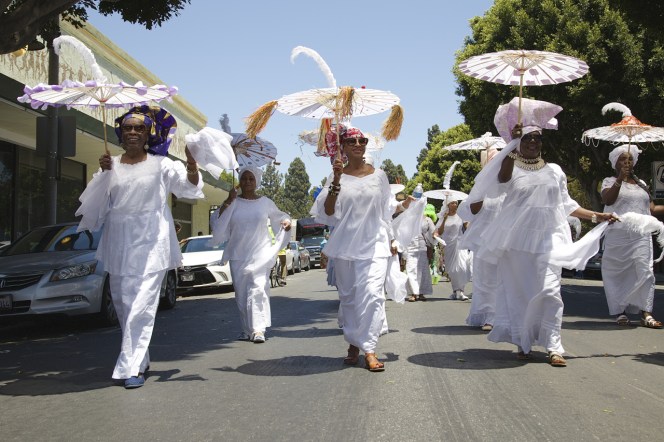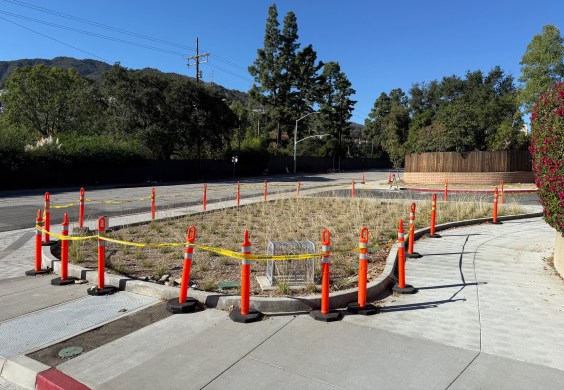"Leimert Park is alive!" rang out over the plaza as those that had gathered in Leimert Park Village's People St Plaza for the Seventh Annual Day of the Ancestors: Festival of Masks followed the drums to the starting point of the procession.
They had already been blessed in English, Spanish, and Yoruba as part of the opening ceremonies on the plaza (above and below).
The theme for this year was "Restoring Balance" and featured artists from a range of spiritual traditions and cultural heritages to both underscore and inspire connections across today's increasingly deeper divides. The processioners were grouped by the elements they represented (earth, water, fire, etc.).
The procession, although only a handful of blocks, was loud and joyful, paying homage to common ancestors, honoring the community, and returning to the plaza to kick off an afternoon of performances by artists from near and far, including SHINE Muwasi, the Lula Washington Dance Theatre, Anahuacalmecac Danza Azteca, Le Ballet Dembaya, Marie Kellier and L.A. Carnival, and more.
It was an incredible day of beauty, grace, community, unity, resilience, culture, heritage, love, family, and transcendence.
But it's not the kind of event Streetsblog or other urbanism advocates tend to write about.
For a variety of reasons, cultural events have been relegated into a different category than "open streets" festivals (e.g. CicLAvia).
It's a distinction that has always bothered me, given the way "open streets" festivals are credited with "activating" public spaces, making them more "vibrant," and "breathing new life" into cities. It's also a distinction that helps to feed "livability" narratives that prioritize (and measure success by) walkability, bike-ability, transit access, and visible activity in the public space.
Not that those things are not important.
But in many historically marginalized urban neighborhoods, decades of disenfranchisement and the repressive policing that accompanied it created great insecurity in the public space and, over time, eroded bonds of social trust between neighbors. With the public space essentially rendered off limits for too many, community had to be nurtured in private spaces - in the corners folks carved out for themselves, their networks of family and friends, fellow artists, and other kindreds.
Leimert Park is unique in that the relationships built in unorthodox art labs, jam sessions, performance spaces, and spoken word, dance, drum, and writing workshops enhanced the ability of the community to gather in the public space. There, they could call upon the entirety of their cultural arsenal to confront injustices and oppressive systems, find comfort and healing in one another, celebrate culture and community, and amplify their voices in the fight to forge a better a future.
Across South Central, there is a growing effort to reclaim the public space. We saw this most recently during the massive march to commemorate the 25th anniversary of the 1992 uprising. Because access can never be taken for granted, such efforts are rarely without reference to the community's resilience in the face of injustice. Even community bike rides are never just community bike rides. At the very least, they always involve mentorship, keeping youth safe from gangs, serving the community, giving riders a sense of purpose, strengthening black-brown unity, and lifting community spirits.
It's an important history that often gets lost as cities and urbanists push for public space projects to improve "livability." [See a recent twitter exchange between myself and Alta Planning around LADOT's images promoting their People St plazas, including the one in Leimert Park (at right, below)]
Instead of acknowledging the factors that shaped marginalized communities' access to and experiences in the public space, places are generally described as needing to be "made" (implying there is nothing there) via simple interventions designed to teach people to "see their streets as sites of recreation." As those biases continue to be enshrined in studies designed to confirm, rather than examine, them and built into toolkits for planners, problematic narratives become standard operating procedure.
The success of cultural events like the mask festival (and the fact that it grows every year) serves as a reminder that much more than polka dots are needed for communities to believe a space is truly meant for its people. And that it takes much more than the closing of a street to cars to make it accessible to black folks. [See our story about the racial profiling of black cyclists riding in the King Day parade.]
With that, I will leave you with images from the day. Find more on L.A. Commons' flickr page. L.A. Commons produces the festival in partnership with the Leimert Park Art Walk, KAOS Network, Motherland Music, Watts Village Theater Co., Watts Labor Community Action Center, Community Build, Lula Washington Dance Theatre, The World Stage, and the Leimert Park Village Stakeholders.






